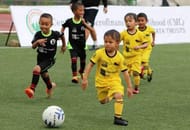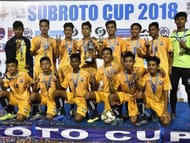Domestic Tournaments: (Scheduling and format)
The scheduling of these tournaments need to be made with certain factors in mind:
- The last half of February and the whole of March should be given as an off-season due to school final exams.
- There needs to be a two-week break in September for mid-terms.
- There will be certain transfer windows at every age level, where club level transfers take place under the purview of the AIFF to avoid age and money fraud.
- The start of the season is considered as June, as most schools in India reopen by then.
SCHOOL LEVEL:
Until the Under 12 level, i.e from ages 5 to 10, the AIFF should continue developing it's Golden Baby Leagues initiative, in collaboration with Reliance's efforts. The Baby League was a masterstroke move in recent times.
Boys and girls can all play semi-professionally on AstroTurf grounds in towns and cities, under the guidance of school and academy coaches. Kids can also play on primary school grounds, public parks, local tourneys, etc. The main aim here is to get as many kids as possible to participate and let the kids play for fun. Those who are interested and/or have some talent will surely move forward to the next level.

BOYS:
UNDER 12
Children would just about move into middle school, and now is the time to introduce them to some professionalism. School teams can be formed, and play the U-12 Reliance Foundation Cup in June and July (hoping that Reliance will be expanding the qualifiers to all parts of India in the coming years).
Clubs hold trials and select players in late July (as per FIFA and AIFF regulations), and the Under-12 I league is held from August to September. School teams can continue playing other age-group city-level tournaments (both 11-a side and not). Players train at school, as well as personally at academies, public grounds, etc.
The target for AIFF: To get players used to a professional level, and try and make boys play as many matches as possible to improve aspects of the game like first touch, passing, dribbling, game awareness, etc. which is better developed at a younger age. Clubs sign their first academy products. No targets at the International level.
UNDER 14:

June-July: Subroto Cup qualifiers to take place in every state (responsibility of AIFF), conducted by the Armed forces in association with State Associations. The state association could use the Armed forces' facilities and conduct a comprehensive state-level school football championship (well-structured like cricket).
The winner represents the state in the Subroto Cup in Delhi. Apart from this, players can continue playing amateur tournaments for school and their academies/semi-pro sides. The state uses this tournament to scout players for the U-14 State team.
August-September: Subroto Cup finals take place in Delhi. First National Team is selected from here. The last half of September is given as a break for Mid-term and Dusshera.
October: State teams are selected and National Championship takes place. Here comes a Diwali transfer window, where top division clubs can hold trials and sign players as per FIFA and AIFF rules. If a player is shifted to a residential academy, he must be registered to a school and must pursue education.
November-February: U-15 I-league kicks off (Transition to U-15 as the year changes). Players who are not a part of this can play the CBSE/ICSE/State Board championships for their schools. National teams selected from among these players whenever a match comes up. A break until the end of March after the end of the league.
April-May: Another transfer window in April, where clubs hold trials, scout players, etc. Players play the U-15 Nike Cup for their clubs in these two months. As schools are generally closed during this time, players who are not a part of this continue playing semi-pro or train at academies.
Targets for AIFF: Firstly, playing the AFC U-14 championships. Then, selecting a strong U-15 side and win the SAFF Championships. Playing friendlies against top sides home and away. Play tournaments like Gothia Cup and other age-group tournaments for exposure. Later merge this squad with the U-16 team selected and become regulars at the AFC U-16 championships. Then go towards targeting the U-17 World Cup.
Domestically, players should play at least 30 games in a year. Game-time is always a key factor in improving technically and tactically for all players.
